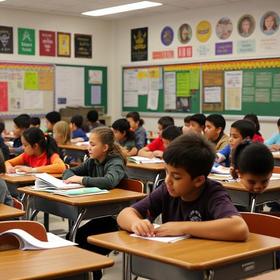A new report card is out for charter schools this month, courtesy of Mathematica Policy Research. The study is considered to be the most comprehensive, longitudinal study on charter school networks to date, and it offers valuable information on whether these public schools are serving the purpose originally intended for them. While data is somewhat mixed throughout the study, there are a few key facts that can be taken from the research to explain why some charter schools are more effective than others.
The CMO and the Study
The Mathematica study revolves around data collected on charter school management organizations or CMOs. These organizations serve as networks that operate multiple charter schools. Currently, there are around 130 CMOs across the country that are responsible for meeting the needs of approximately 250,000 students. While this number does not encompass all of the charter schools in operation currently, the number of schools overseen by CMOs has been growing. According to the published study, CMOs started out overseeing about six percent of all charter schools. Today, that number has grown to 17 percent.
According to a press release on Mathematica’s website, this latest study selected 40 CMOs to examine management practices and instruction methodology at 40 of these organizations to determine how effective they were in impacting the achievement of students within their schools. Of that 40, 22 networks provided sufficient data for accurate analysis. The core of the study was achievement in the middle school years, which these 22 CMOs were able to adequately provide numbers for in at least four of the schools included in each network.
Many CMOs are primarily designed to replicate educational approaches that work particularly well among disadvantaged students. This is one of the reasons charter schools are a popular choice in communities with underachieving public schools – where many disadvantaged students often live. With this fact in mind, the study sought to evaluate national achievement efforts for these organizations and provide useful guidance to other CMOs, charter schools, and public schools around the country.
This video examines the effectiveness of charter schools.
The Effectiveness of CMOs
The results of the Mathematica research were mixed, with the majority of CMOs studies providing positive effects with students and a few underachieving compared to other public schools in the area.
“CMOs are an important part of the education landscape and a subject of significant national attention,” Joshua Haimson, senior researcher for Mathematica stated in the press release on the website. “Among the CMOs for which we were able to assess academic impact, many are having a strong positive effect, but some underperform relative to nearby public schools. Our findings on promising practices can inform efforts to improve school performance and substantially close school achievement gaps.”
Throughout the study, some relevant patterns were seen with the successful CMOs, including:
- CMOs typically have smaller schools than their public counterparts
- Classroom sizes were smaller on average than other schools
- CMOs offer additional instructional time, through extended school days or shorter vacations
- CMOs are less likely to standardize curriculum for all of their schools
- These organizations tend to offer more intense coaching to teachers
- CMOs have a greater tendency to issue school-wide disciplinary policies
- These management organizations are more likely to pay teachers based on performance
These patterns could be used in the future for other CMOs, charter schools, and public schools, to increase performance in these institutions as well.
This video compares public schools with charter schools.
Results of the Study
In a nutshell, the Mathematica study found that of the 22 CMOs studies, 10 networks were outperforming nearby public schools in mathematics and reading, according to a report at Time. For the CMOs that were high achieving, students were getting the equivalent of three years of instruction in just two years of class time. In addition, students that were considered high achieving also outperformed their peers in subjects like science and social studies, suggesting that gains made in core curriculum areas were not made at the expense of other subjects.
The study also showed that some of the next eight CMOs studied also outperformed other neighboring schools, but not by much in this case. In fact, the data did not offer a statistically significant difference, leading to a possible conclusion that while these schools were on par with other public schools, they were not offering much additional benefit to the students who attended. A few of the schools in this eight were also behind other public schools in core subjects like math and reading, with a few showing a significant drop from the average seen in nearby public schools.
The final four CMOs examined in this study were shown to be seriously lagging behind other schools in their areas. In these underperforming schools, students were shown to be academically lagging behind others in their grades within two years of enrolling in the charter school. This has led to some discussion among educators and academic experts on the need to become more efficient in closing charter schools that do not live up to expectations or standards relatively quickly.
“We need to replicate what’s working within these high performers to ensure that all students can thrive in a high-quality public school,” Ursula Wright, president, and CEO of the National Alliance for Public Charter Schools stated in a press release on PR Newswire. “At the same time, we must also as a movement acknowledge that there is a small subset of CMOs that are not serving their students well. It is important that we take these results seriously and encourage charter authorizers, and the rest of the charter school community, to take steps to ensure that all public charter schools are meeting their intended promise.”
Questions? Contact us on Facebook. @publicschoolreview











